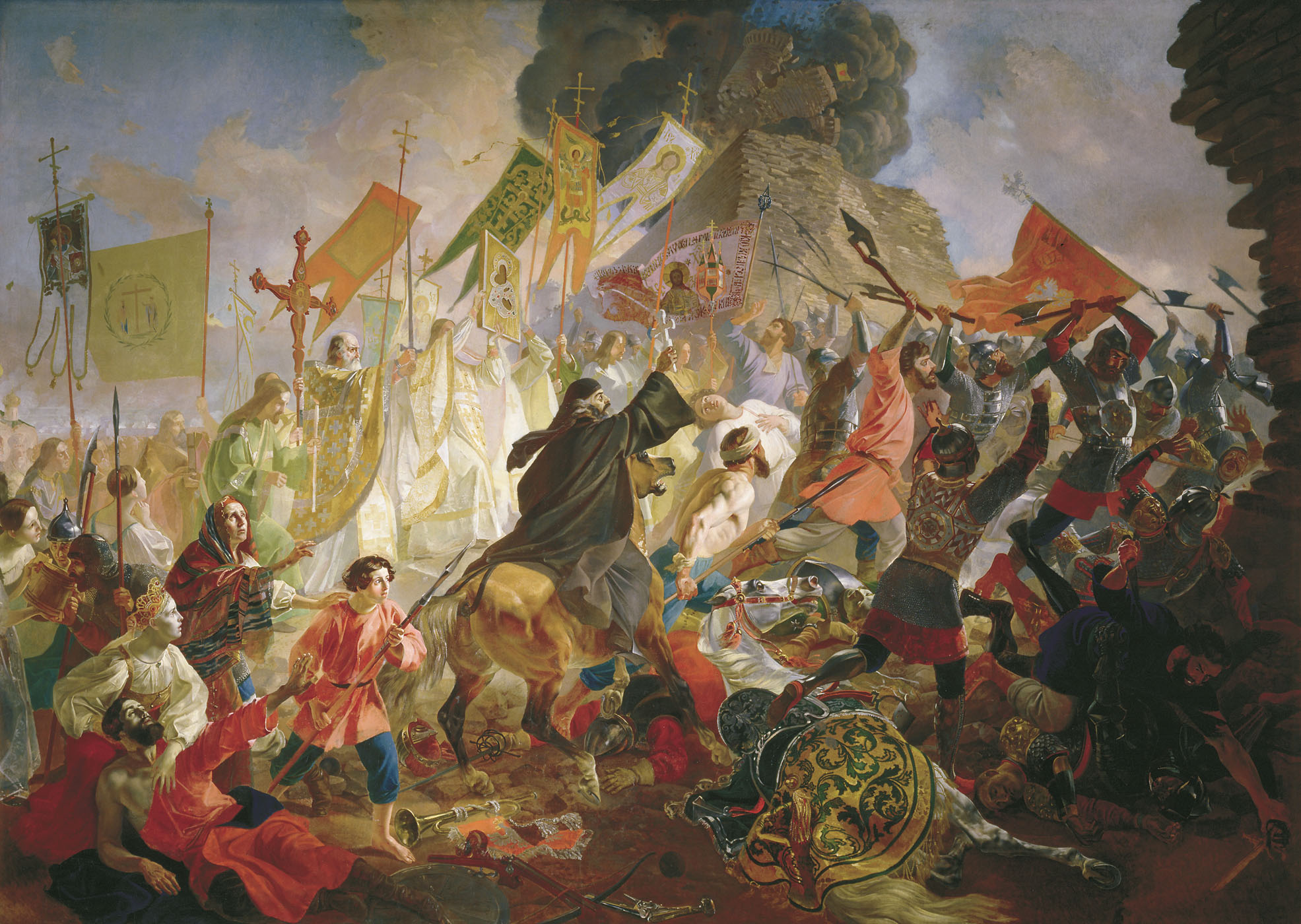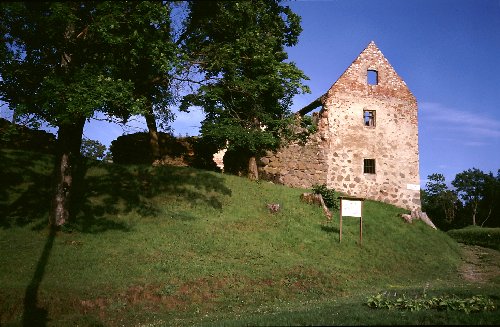|
Ludza Castle
Ludza Castle ( lv, Ludzas pils, german: Ordensburg Ludsen) was a medieval castle built in Gothic style located next to a Catholic church, on the site of a former Latgalian wooden castle in the centre Ludza, Latvia, a small town in eastern Latgale. Its main purpose was to be an eastern outpost to control trade routes from Russia. Nowadays the impressive fragments of the castle walls, including a three-floor high fragment, still remain. The ruins are the main tourist attraction in the Ludza District, and is considered a symbol of the town. History The first mention of the castle dates from 1433 when the Livonian Order built a larger and stronger fortress to replace an earlier wooden fortress built by the ancient Latgalians. The Ludza stone castle had three stories, six towers, three gates and two foreparts. It was built as an outpost for the Livonian order, mainly to strengthen the eastern border of Livonia and guard trade routes from Russia. In 1481 the Russians invaded Livonia, o ... [...More Info...] [...Related Items...] OR: [Wikipedia] [Google] [Baidu] |
Ludza
Ludza (; pl, Lucyn, german: Ludsen, russian: Лудза, ''Ludza'') is a town in the Latgale region of eastern Latvia. Ludza is the oldest town in Latvia and this is commemorated by a key in its coat of arms. Ludza is the administrative centre of Ludza Municipality that is located nearby the Russian border. The population as of 2020 was 7,667. History After Nikolay Karamzin, Ludza was first mentioned as ''Лючин'' in Hypatian Codex dating back to 1173 or 1177. In 1399 the Livonian Order built a stone fortress atop an older Latgalian fortress and used Ludza as an eastern outpost in Livonia. Ludza Castle ruins can be visited nowadays. Polish-Lithuanian Commonwealth After the dissolution of the Livonian Order in 1561, Ludza was incorporated to the Polish–Lithuanian Commonwealth and became part of Wenden Voivodeship. In January 1626, during the Polish-Swedish War, Ludza was captured without a battle by Sweden due to defeat of the forces of Polish-Lithuanian marshal Jan Stan ... [...More Info...] [...Related Items...] OR: [Wikipedia] [Google] [Baidu] |
Pskov
Pskov ( rus, Псков, a=pskov-ru.ogg, p=pskof; see also names in other languages) is a city in northwestern Russia and the administrative center of Pskov Oblast, located about east of the Estonian border, on the Velikaya River. Population: Pskov is one of the oldest cities in Russia. It served as the capital of the Pskov Republic and was a trading post of the Hanseatic League before it came under the control of the Grand Duchy of Moscow. History Early history Pskov is one of the oldest cities in Russia. The name of the city, originally Pleskov (historic Russian spelling , ''Plěskov''), may be loosely translated as "he townof purling waters". It was historically known in English as Plescow. Its earliest mention comes in 903, which records that Igor of Kiev married a local lady, Olga (later Saint Olga of Kiev). Pskovians sometimes take this year as the city's foundation date, and in 2003 a great jubilee took place to celebrate Pskov's 1,100th anniversary. The f ... [...More Info...] [...Related Items...] OR: [Wikipedia] [Google] [Baidu] |
List Of Castles In Latvia
This is the List of castles in Latvia, which includes fortified residences of Western European conquerors built in the area of present-day Latvia before the 17th century. There are about 140 medieval castles in the area, therefore this list is not complete. After the name of the castle comes the year of construction and a short description of its present-day condition. Table of contents Courland Zemgale Vidzeme Latgale See also *List of castles *List of castles in Estonia *List of palaces and manor houses in Estonia *List of palaces and manor houses in Latvia * List of hillforts in Latvia *List of castles in Lithuania Additional information References Sources * * External links Ambermarks - Medieval castles of Latvia - list {{List of castles in Europe * Latvia Cas Lists of castles by country Castles A castle is a type of fortified structure built during the Middle Ages predominantly by the nobility or royalty and by military orders. Scholars debate the ... [...More Info...] [...Related Items...] OR: [Wikipedia] [Google] [Baidu] |
Russian-Polish War
Armed conflicts between Poland (including the Polish–Lithuanian Commonwealth) and Russia (including the Soviet Union) include: Originally a Polish civil war that Russia, among others, became involved in. Originally a Hungarian revolution but was joined with Polish force on Hungarian side against Austria and Russia. Part of the broader Russian Revolution of 1905. See also * * * * * – in most of which Kingdom of Poland was allied with the Grand Duchy of Lithuania The Grand Duchy of Lithuania was a European state that existed from the 13th century to 1795, when the territory was partitioned among the Russian Empire, the Kingdom of Prussia, and the Habsburg Empire of Austria. The state was founded by Li ... * * * * * * References {{DEFAULTSORT:Polish-Russian War Lists of military conflicts ... [...More Info...] [...Related Items...] OR: [Wikipedia] [Google] [Baidu] |
Inflantia
The Inflanty Voivodeship ( pl, Województwo inflanckie), or ''Livonian Voivodeship'', also known as Polish Livonia, was an administrative division and local government in the Polish–Lithuanian Commonwealth, since it was formed in the 1620s out of the Wenden Voivodeship and lasted until the First Partition of Poland in 1772. The Inflanty Voivodeship was one of the few territories of the Polish–Lithuanian Commonwealth to be ruled jointly by Poland and Lithuania. Overview The Inflanty Voivodeship, also called the ''Duchy of Inflanty'', due to a 1667 bill of the Sejm, was the minority remainder of the Duchy of Livonia, which had been conquered by the Swedish Empire during the Polish–Swedish War of 1621–1625. The seat of the voivode was Dyneburg (Daugavpils). The name ''Inflanty'' is derived through Polonization of ''Livland'', the German name for Livonia. In modern times the region is known as Latgalia in the Republic of Latvia. [...More Info...] [...Related Items...] OR: [Wikipedia] [Google] [Baidu] |
Ivan The Terrible
Ivan IV Vasilyevich (russian: Ива́н Васи́льевич; 25 August 1530 – ), commonly known in English as Ivan the Terrible, was the grand prince of Moscow from 1533 to 1547 and the first Tsar of all Russia from 1547 to 1584. Ivan was the son of Vasili III, the Rurikid ruler of the Grand Duchy of Moscow. He was appointed grand prince after his father's death, when he was three years old. A group of reformers known as the "Chosen Council" united around the young Ivan, declaring him tsar (emperor) of all Rus' in 1547 at the age of 16 and establishing the Tsardom of Russia with Moscow as the predominant state. Ivan's reign was characterised by Russia's transformation from a medieval state to an empire under the tsar but at an immense cost to its people and its broader, long-term economy. During his youth, he conquered the khanates of Kazan and Astrakhan. After he had consolidated his power, Ivan rid himself of the advisers from the "Chosen Council" and triggered the ... [...More Info...] [...Related Items...] OR: [Wikipedia] [Google] [Baidu] |
Livonian War
The Livonian War (1558–1583) was the Russian invasion of Old Livonia, and the prolonged series of military conflicts that followed, in which Tsar Ivan the Terrible of Russia (Muscovy) unsuccessfully fought for control of the region (present-day Estonia and Latvia). The Tsardom of Russia (Muscovy) faced a varying coalition of the Dano-Norwegian Realm, the Kingdom of Sweden, and the Union (later Commonwealth) of the Grand Duchy of Lithuania and the Kingdom of Poland. From 1558 to 1578, Russia controlled the greater part of the region with early military successes at Dorpat (Tartu) and Narwa (Narva). The dissolution of the Livonian Confederation brought Poland–Lithuania into the conflict, and Sweden and Denmark intervened between 1559 and 1561. Swedish Estonia was established despite continuing attacks from Russia, and Frederick II of Denmark bought the old Bishopric of Ösel–Wiek, which he placed under the control of his brother Magnus of Holstein. Magnus attemp ... [...More Info...] [...Related Items...] OR: [Wikipedia] [Google] [Baidu] |
Latgale
Latgale ( ltg, Latgola; ; ger, Lettgallen; be, Латгалія, Łathalija; pl, Łatgalia; la, Lettgallia), also known as Latgalia is one of the Historical Latvian Lands. It is the easternmost region and is north of the Daugava River. While most of Latvia is historically Lutheran, Latgale is predominantly Roman Catholic: 65.3% according to a 2011 survey. There is also a strong Eastern Orthodox minority (23.8%), of which 13.8% are Russian Orthodox Christians and 10.0% are Old Believers. As of 2020, the region's population was 255,968. The region has a large population of ethnic Russians, especially in Daugavpils, the largest city in the region and the location of the region's only public university, the University of Daugavpils. Many of the Russians who lived in Latgale before Soviet rule are Old Believers. Rēzekne, often called the heart of Latgale, Krāslava, and Ludza are other large towns in the region, which also has a Belarusian minority. There is also a significant ... [...More Info...] [...Related Items...] OR: [Wikipedia] [Google] [Baidu] |
Tsar
Tsar ( or ), also spelled ''czar'', ''tzar'', or ''csar'', is a title used by East Slavs, East and South Slavs, South Slavic monarchs. The term is derived from the Latin word ''Caesar (title), caesar'', which was intended to mean "emperor" in the European medieval sense of the term—a ruler with the same rank as a Roman emperor, holding it by the approval of another emperor or a supreme ecclesiastical official (the Pope or the Ecumenical Patriarch)—but was usually considered by western Europeans to be equivalent to "king". It lends its name to a system of government, tsarist autocracy or tsarism. "Tsar" and its variants were the official titles of the following states: * Bulgarian Empire (First Bulgarian Empire in 681–1018, Second Bulgarian Empire in 1185–1396), and also used in Kingdom of Bulgaria, Tsardom of Bulgaria, in 1908–1946 * Serbian Empire, in 1346–1371 * Tsardom of Russia, in 1547–1721 (replaced in 1721 by ''imperator'' in Russian Empire, but still re ... [...More Info...] [...Related Items...] OR: [Wikipedia] [Google] [Baidu] |
Grand Duchy Of Moscow
The Grand Duchy of Moscow, Muscovite Russia, Muscovite Rus' or Grand Principality of Moscow (russian: Великое княжество Московское, Velikoye knyazhestvo Moskovskoye; also known in English simply as Muscovy from the Latin ) was a Rus' principality of the Late Middle Ages centered on Moscow, and the predecessor state of the Tsardom of Russia in the early modern period. It was ruled by the Rurik dynasty, who had ruled Rus' since the foundation of Novgorod in 862. Ivan III the Great titled himself as Sovereign and Grand Duke of All Rus' (russian: государь и великий князь всея Руси, gosudar' i velikiy knyaz' vseya Rusi). The state originated with the rule of Alexander Nevsky of the Rurik dynasty, when in 1263, his son, Daniel I, was appointed to rule the newly created Grand Principality of Moscow, which was a vassal state to the Mongol Empire (under the "Tatar Yoke"), and which eclipsed and eventually absorbed its parent duchy ... [...More Info...] [...Related Items...] OR: [Wikipedia] [Google] [Baidu] |
.jpg)







